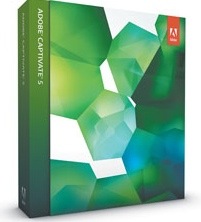By David Creamer
Adobe Captivate from Adobe (http://www.adobecom) is an US$799 program that allows the creation of online demonstrations and interactive assessments, usually of other software programs, but it can be used for presentations, too. Although Captivate has been around for a quite some time, this is the first version available for both Macintosh and Windows.
Whether you’re upgrading a Windows version or purchasing the first Macintosh version, Captivate is a powerful program that does more than just record a video of your onscreen actions. When you simply click the mouse, Captivate creates screen captures then adds mouse animations and captions; of course, it can do full motion recording (FMR) either automatically when required or be set to FMR all the time. The slides can then be customized with text captions, buttons, click boxes, rollover captions, and more.
Captivate 5 sports a new Adobe interface with new panel workspaces. Once you get used to the new interface, it’s much more productive than in older versions. Other new features include Master Slides and Object Styles — the former is similar to PowerPoint Master Slides and the latter is similar to InDesign Object Styles.
The Master Slide feature allows the creating of masters that can be applied to individual slides as required; when the masters are updated, the individual slides update, too. The same principle applies for Object Styles — these styles are for the individual objects on the slides and update globally.
Speaking of PowerPoint, PowerPoint presentations can be imported into Captivate with almost all of the PowerPoint animation intact, plus you can link to the PowerPoint file so edits in PowerPoint can be updated back in Captivate. Other programs that allow round-tripping include Photoshop, Soundbooth, and Flash, but unfortunately, you have to have the full eLearning Suite to round-trip with these programs (all of these programs are included in the eLearning Suite). Photoshop files can be imported with layer support, audio files can be edited with Soundbooth (or directly in Captivate), and Flash-created SWF files can be imported.
My biggest complaint with version 5 is that the round-tripping doesn’t work if you already own Photoshop, Soundbooth, and Flash (from the CS5 Master Collection, for example). That makes no sense to me and I hope this is addressed in a future update. (Of course, one could argue that Captivate should be part of the Master Collection.)
Flash video can be imported, and to make the importing of other formats easier, Captivate now includes Adobe Media Encoder. If you don’t like recording your own audio, you can turn your slide notes into spoken text with the text-to-speech converter.
Creating scored quizzes has always been one of the useful features of Captivate. These quizzes can create branches in the presentation allowing the user to continue viewing the Captivate project or review a section all over again based on the quiz score. In the past, the quiz scores could be sent to a Learning Management System (LMS) or to an email address. New to version 5 is the ability to also upload the presentations to Acrobat.com and collect the data with the new Quiz Results Analyzer. This feature is very useful for small groups that don’t have the need for an expensive LMS.
Output is normally as a SWF file, although interactive PDF and non-interactive Flash video file formats are available, too. The SWF file can include custom skins and a table of contents (ToC), plus multiple Captivate SWFs can be combined together into a single SWF presentation with Aggregator.
Rating: 9 out of 10
(This review is brought to you courtesy of “Layers Magazine”: http://layersmagazine.com/).


